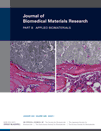Tissue engineering of small-diameter vascular grafts by endothelial progenitor cells seeding heparin-coated decellularized scaffolds†
How to cite this article: Zhou M, Liu Z, Liu C, Jiang X, Wei Z, Qiao W, Ran F, Wang W, Qiao T, Liu C. 2012. Tissue engineering of small-diameter vascular grafts by endothelial progenitor cells seeding heparin-coated decellularized scaffolds. J Biomed Mater Res Part B 2012:100B:111-120.
Abstract
Successful construction of a small-diameter bioartificial vascular graft remains a great challenge. This study reports on novel tissue engineering vascular grafts (TEVGs) constructed by endothelial progenitor cells and heparin-coated decellularized vessels (DV). The DVs were fabricated from canine carotid arteries with observable depletion of cellular components. After heparin coating, the scaffolds possessed excellent antithrombogeneity. Canine endothelial progenitor cells harvested from peripheral blood were expanded and seeded onto heparin-coated DVs and cocultured in a custom-made bioreactor to construct TEVGs. Thereafter, the TEVGs were implanted into the carotid arteries of cell-donor dogs. After 3 months of implantation, the luminal surfaces of TEVGs exhibited complete endothelium regeneration, however, only a few disorderly cells and thrombosis overlaid the luminal surfaces of control DVs grafts, and immunofluorescent staining showed that the seeded cells existed in the luminal sides and the medial parts of the explanted TEVGs and partially contributed to the endothelium formation. Specifically, TEVGs exhibited significantly smaller hyperplastic neointima area compared with the DVs, not only at midportion (0.64 ± 0.08 vs. 2.13 ± 0.12 mm2, p < 0.001), but also at anastomotic sites (proximal sites, 1.03 ± 0.09 vs. 3.02 ± 0.16 mm2, p < 0.001; distal sites, 1.84 ± 0.15 vs. 3.35 ± 0.21 mm2, p < 0.001). Moreover, TEVGs had a significantly higher patency rate than the DVs after 3 months of implantation (19/20 vs. 12/20, p < 0.01). Overall, this study provided a new strategy to develop small-diameter TEVGs with excellent biocompatibility and high patency rate. © 2011 Wiley Periodicals, Inc. J Biomed Mater Res Part B: Appl Biomater, 2012.




